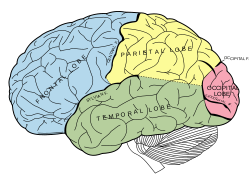In an article called “The Neuroscience of Leadership” (free registration required*), from Strategy + Business a few years ago, the writers explain how new understanding about how the brain works helps us see why it’s so hard for us to fully comprehend new ideas. I keep cycling back to this article since I read it just a few months ago, because it helps me put a lot of things that have perpetually bedeviled me in a better perspective.
One particularly salient bit:
Attention continually reshapes the patterns of the brain. Among the implications: People who practice a specialty every day literally think differently, through different sets of connections, than do people who don’t practice the specialty. In business, professionals in different functions — finance, operations, legal, research an development, marketing, design, and human resources — have physiological differences that prevent them from seeing the world the same way.
Note the word “physiological.” We tend to assume that people’s differences of opinion or perspective are more like software — something with a switch that the person could just flip to the other side, if they simply weren’t so stubborn. The problem is, the brain grows hardware based on repeated patterns of experience. So, while stubbornness may be a factor, it’s not so simple as we might hope to get another person to understand a different perspective.
Recently I’ve had a number of conversations with colleagues about why certain industries or professions seem stuck in a particular mode, unable to see the world changing so drastically around them. For example, why don’t most advertising and marketing professionals get that a website isn’t about getting eyeballs, it’s about creating useful, usable, delightful interactive experiences? And even if they nod along with that sentiment in the beginning, they seem clueless once the work starts?
Or why do some or coworkers just not seem to get a point you’re making about a project? Why is it so hard to collaborate on strategy with an engineer or code developer? Why is it so hard for managers to get those they manage to understand the priorities of the organization?
And in these conversations, it’s tempting — and fun! — to somewhat demonize the other crowd, and get pretty negative about our complaints.
While that may feel good (and while my typing this will probably not keep me from sometimes indulging in such a bitch-and-moan session), it doesn’t help us solve the problem. Because what’s at work here is a fundamental difference in how our brains process the world around us. Doing a certain kind of work in a particular culture of others that work creates a particular architecture in our brains, and continually reinforces it. If your brain grows a hammer, everything looks like a nail; if it grows a set of jumper cables, everything looks like a car battery.
Now … add this understanding to the work Jonathan Haidt and others have done showing that we’re already predisposed toward deep assumptions about fundamental morals and values. Suddenly it’s pretty clear why some of our biggest problems in politics, religion, bigotry and the rest are so damned intractable.
But even if we’re not trying to solve world hunger and political turmoil, even if we’re just trying to get a coworker or client to understand a different way of seeing something, it’s evident that bridging the gap in understanding is not just a peripheral challenge for doing great design work — it may be the most important design problem we face.
I don’t have a ready remedy, by the way. But I do know that one way to start building bridges over these chasms of understanding is to look at ourselves, and be brutally honest about our own limitations.
I almost titled this post “Why Some People Just Don’t Get It” — but I realized that sets the wrong tone right away. “Some People” becomes an easy way to turn others into objects of ridicule, which I’ve done myself even on this blog. It’s easy, and it feels good for a while, but it doesn’t help the situation get better.
As a designer, have you imagined what it’s like to see the world from the other person’s experience? Isn’t that what we mean when we say the “experience” part of “user experience design” — that we design based on an understanding of the experience of the other? What if we treated these differences in point of view as design problems? Are we up to the challenge?
Later Edit:
There have been some excellent comments, some of which have helped me see I could’ve been more clear on a couple of points.
I perhaps overstated the “hardware” point above. I neglected to mention the importance of ‘neuroplasticity‘ — and that the very fact we inadvertently carve grooves into the silly-putty of our brains also means we can make new grooves. This is something about the brain that we’ve only come to understand in the last 20-30 years (I grew up learning the brain was frozen at adulthood). The science speaks for itself much better than I can poorly summarize it here.
The concept has become very important to me lately, in my personal life, doing some hard psychological work to undo some of the “wiring” that’s been in my way for too long.
But in our role as designers, we don’t often get to do psychotherapy with clients and coworkers. So we have to design our way to a meeting of minds — and that means 1) fully understanding where the other is coming from, and 2) being sure we challenge our own presuppositions and blind spots. This is always better than just retreating to “those people don’t get it” and checking out on the challenge altogether, which happens a lot.
Thanks for the comments!
* Yet another note: the article is excellent; a shame registration is required, but it only takes a moment, and in this case I think it’s worth the trouble.



